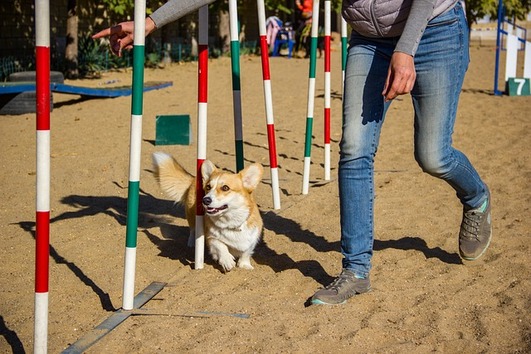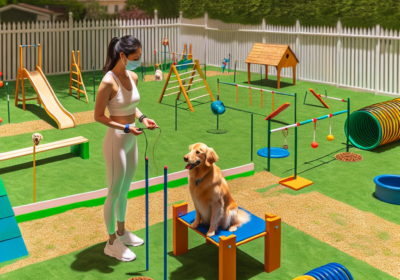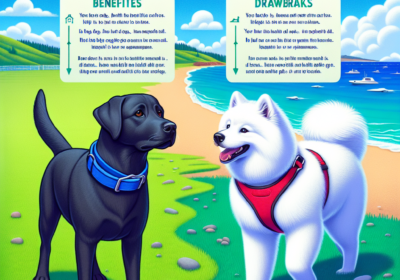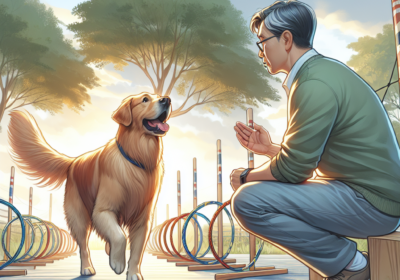The Benefits to Dogs and Owners of Dog Agility Training

Dog agility training has gained significant popularity in recent years, attracting dog owners and enthusiasts worldwide. This exciting and dynamic sport involves guiding dogs through obstacle courses, testing their agility, obedience, and teamwork. While dog agility training offers an enjoyable activity for both dogs and their owners, its benefits extend far beyond just a thrilling pastime. In this article, we will explore the numerous advantages of dog agility training, focusing on the physical, mental, and emotional well-being of dogs and the positive impact it has on their owners.
Physical Fitness and Health Benefits
One of the most apparent advantages of dog agility training is the improvement it brings to a dog’s physical fitness. Agility courses are designed to promote endurance, strength, and flexibility. As dogs navigate obstacles such as jumps, tunnels, weave poles, and seesaws, they engage their muscles and develop better coordination and balance.
Regular agility training helps to build cardiovascular endurance, enhancing overall stamina and reducing the risk of obesity, a prevalent health concern among dogs. Furthermore, the repetitive movements involved in agility training can help maintain joint health, increase bone density, and prevent age-related issues such as arthritis.
Mental Stimulation and Cognitive Development
Dogs, like humans, need mental stimulation to prevent boredom and promote overall well-being. Agility training provides an excellent outlet for mental exercise, as dogs are required to learn and execute a variety of commands and navigate complex obstacle courses.
The cognitive benefits of agility training are significant. Dogs must memorize obstacle sequences, respond to verbal and visual cues, and make split-second decisions while navigating the course. This mental stimulation enhances problem-solving skills, improves focus and concentration, and boosts overall cognitive function.
Enhanced Bonding and Communication
Participating in agility training with your dog can strengthen the bond between you and your furry companion. The shared experience of working together to overcome obstacles and complete the course fosters trust, cooperation, and a deeper understanding of each other’s abilities.
Through agility training, dogs become more attuned to their owner’s cues, both verbal and non-verbal. This heightened level of communication extends beyond the agility course, improving obedience and responsiveness in everyday situations. The teamwork involved in agility training deepens the emotional connection between dogs and their owners, leading to a more fulfilling and harmonious relationship.
Increased Confidence and Self-Esteem
Dog agility training can have a profound impact on a dog’s self-confidence and self-esteem. As dogs master obstacles and successfully complete courses, they gain a sense of accomplishment and pride. Positive reinforcement and encouragement during training sessions further enhance their confidence, motivating them to tackle challenges with enthusiasm.
For shy or anxious dogs, agility training can be particularly beneficial. The controlled environment and positive reinforcement create a safe space for them to overcome fears and build self-assurance. As they grow more confident in their abilities, their overall behavior and social interactions outside of the training environment also tend to improve.
Stress Relief and Behavioral Improvement
Regular exercise, such as agility training, plays a vital role in preventing and alleviating stress in dogs. Physical activity stimulates the release of endorphins, which are natural mood enhancers. Agility training provides an outlet for dogs to release excess energy and mental tension, reducing the likelihood of behavioral issues associated with boredom or frustration.
Engaging in agility training can help prevent destructive behaviors, excessive barking, and separation anxiety, as dogs are mentally and physically exhausted after a training session. Additionally, the structured nature of agility training promotes discipline and self-control, leading to better overall behavior and obedience in various environments.
Energy Outlet and Behavioral Channeling
Many dog breeds have high energy levels and a natural inclination for physical activity. Without appropriate outlets for their energy, these dogs can become restless, anxious, or exhibit destructive behavior. Agility training provides an ideal channel for these dogs to release their pent-up energy in a structured and controlled environment.
By engaging in regular agility training sessions, dogs have a productive and stimulating way to burn off excess energy. This helps prevent the development of behavioral problems such as excessive barking, digging, or chewing. Dogs who participate in agility training often display improved focus, calmness, and a reduced likelihood of engaging in destructive behaviors at home.
Socialization Opportunities
Participating in agility training exposes dogs to various environments, people, and other dogs, providing valuable socialization opportunities. Agility classes and competitions bring together dogs of different breeds and temperaments, allowing them to interact in a controlled setting.
Through these interactions, dogs learn appropriate social behaviors, become accustomed to different handling styles, and develop better communication skills. Socialization helps dogs become more confident, adaptable, and comfortable in various social situations, which can have a positive impact on their behavior outside of the training environment.
Fun and Enriching Activity
Beyond the physical and mental benefits, agility training is simply a fun and enriching activity for dogs and owners alike. The exhilaration of running through the course, overcoming obstacles, and achieving goals together creates a sense of accomplishment and satisfaction for both parties.
For dogs, agility training taps into their innate instincts and provides an outlet for their natural abilities. It channels their drive to chase, jump, and navigate obstacles in a controlled and purposeful manner. The joy and enthusiasm dogs display while participating in agility training is infectious and can bring immense happiness to their owners.
For owners, agility training offers an exciting and engaging way to bond with their dogs. It provides an opportunity to connect on a deeper level and work together towards a common goal. The satisfaction of witnessing their dog’s progress, mastering new skills, and achieving personal bests in competitions can be incredibly rewarding for owners.
Channeling Excess Drive and Energy
Certain dog breeds are known for their high drive and energy levels. This excess drive, if not properly channeled, can lead to behavioral issues and frustration for both the dog and the owner. Dog agility training provides an outlet for these breeds to use their drive in a positive and productive way.
By engaging in agility training, dogs with high energy levels have a constructive activity to focus on. The mental and physical challenges presented by the agility course help to exhaust their energy in a controlled and purposeful manner. This can lead to a calmer and more balanced temperament in these dogs, reducing the likelihood of destructive behaviors or hyperactivity.
Strengthening Trust and Reliability
Through agility training, dogs learn to trust their owners implicitly. They rely on their owners’ guidance and cues to navigate the course successfully. This process strengthens the bond between dog and owner and enhances the dog’s trust and confidence in their owner’s ability to lead them.
As dogs become more responsive to their owners’ commands and cues during agility training, this improved reliability extends to other aspects of their lives. Owners often find that their dogs become more obedient and attentive outside of the agility course, making everyday interactions and training sessions more effective.
Mental and Physical Challenges for Older Dogs
Dog agility training is not just for young and energetic dogs. It can also be beneficial for older dogs. While the intensity and difficulty level can be adjusted to suit their abilities, agility training provides mental and physical stimulation for older dogs, keeping their minds sharp and bodies active.
For senior dogs, agility training helps maintain joint flexibility, muscle tone, and overall physical fitness. The mental challenges involved in navigating the course also provide cognitive stimulation, which can slow cognitive decline and contribute to a higher quality of life in older dogs.
Competitive Opportunities
For those who enjoy a competitive aspect, dog agility training opens doors to various competitions and events. Participating in agility trials allows dogs and their owners to showcase their skills, compete against others, and earn titles and recognition for their achievements.
Competitions provide an additional layer of motivation and excitement for both dogs and owners. They offer a chance to test their abilities, set goals, and experience the thrill of performing at a high level. Engaging in competitive agility can be a fulfilling and rewarding experience, bringing a sense of accomplishment and camaraderie among participants.
Conclusion
Dog agility training offers numerous benefits for both dogs and their owners. From the physical fitness and mental stimulation it provides to the enhanced bonding and communication between dogs and their owners, agility training is an excellent way to promote the well-being of dogs and foster a stronger relationship.
Beyond the obvious advantages, such as improved physical health and cognitive development, agility training can boost a dog’s confidence, relieve stress, and address behavioral issues. As an owner, investing time and effort into agility training can be incredibly rewarding, leading to a happier, healthier, and more well-behaved furry companion. So why not grab a leash, find a local agility class, and embark on an exciting journey of agility training with your dog? The benefits are abundant, and the memories you create will last a lifetime.
Article suggested by “Dog Agility Sunshine Coast“







![The Dog Podcast Uncovers Startling Truths About What We Feed Our Dogs [Press Release]](https://yourhomeandgardenhub.com.au/wp-content/uploads/2024/08/dog-bowl-400x280.webp)


